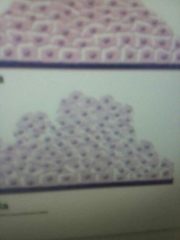![]()
![]()
![]()
Use LEFT and RIGHT arrow keys to navigate between flashcards;
Use UP and DOWN arrow keys to flip the card;
H to show hint;
A reads text to speech;
32 Cards in this Set
- Front
- Back
|
Active transport |
Move substances against cx gradient |
|
|
Exocytosis |
Released from vacuole |
|
|
Endocytosis |
Cell engulf particles and forms a vacuole |
|
|
Phagocytosis |
Engulfs and destroys particles |
|
|
Anaplasia |
Highly pleomorphic and bizarre cytologic features associated with malignant tumors |
|
|
Atrophy |
Decrease in number or size of cells |
|
|
Dysplasia |

Abnormal cytologic features and tissue organization |
|
|
Hyperplasia |
Increase in the number of cells |
|
|
Hypertrophy |
Increase in cell size |
|
|
Metaplasia |
Change from one adult cell type to another |
|
|
Nucleoli |
Site of ribosomal rna synthesis |
|
|
Chromatin |
Thread like Nucleic acids and proteins |
|
|
Chromosomes |
Condensed chromatin |
|
|
Karyotype |
Arrangement of chromosomes |
|
|
Trisomy |
Failure of homologous chromosomes to separate leading to a set of 3 chromosomes |
|
|
Allele |
One of 2 genes that occur at the same locus on the same homologous chromosomes |
|
|
Sickle cell mutation |
Glutamic acid is replaced by valine |
|
|
Organs of hematopoiesis in fetal life |
Liver and spleen |
|
|
What chemical substances are responsible for differentiation of pluripotent stem cells? |
Cytokines |
|
|
Hematopoiesis in adults |
Distal long bones and axial skeleton |
|
|
Pluripotential stem cell |
Present several days after fertilization Develop into any type of cell except a fetus |
|
|
Multipotential stem cell |
Derived from pluripotential stem cells Limited to certain types of cells |
|
|
Multipotential hematopoietic stem cell |
Self renewal capability Progenitor of all blood cells |
|
|
Extramedullary hematopoiesis |
In cases where bone marrow can no longer keep up with cell production the spleen, liver, and lymph nodes revert back to production of cells |
|
|
Monocytes |
Kidney bean or s shaped nucleus |
|
|
Common lymphoid progenitor |
Differentiates into TNK and BCP |
|
|
Common myeloid progenitor |
Differentiates into MEP and GM |
|
|
TNK |
T cells and natural killer cells |
|
|
BCP |
B cells |
|
|
MEP |
Becomes anuclear cells MP (platelet) and EP (erythrocyte)
|
|
|
GMP |
MP (monocyte) and GP (granulocyte) |
|
|
Granulocyte |
Neutrohil Eosinophil Basophil |

